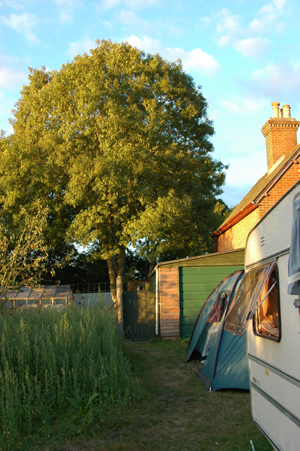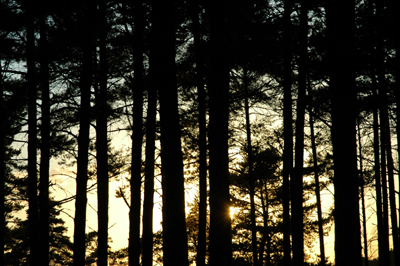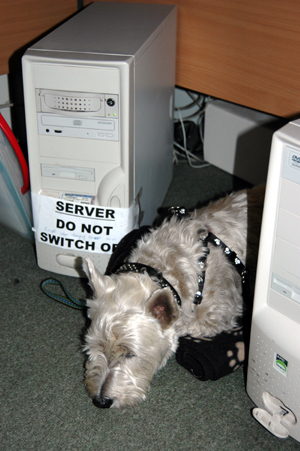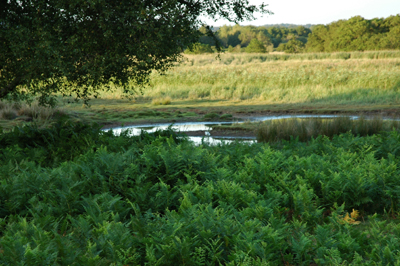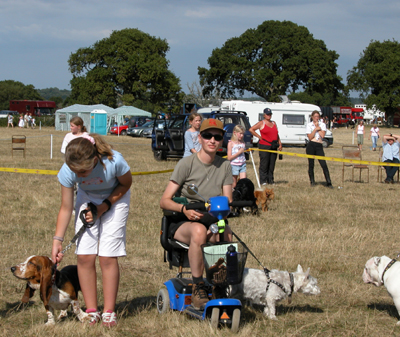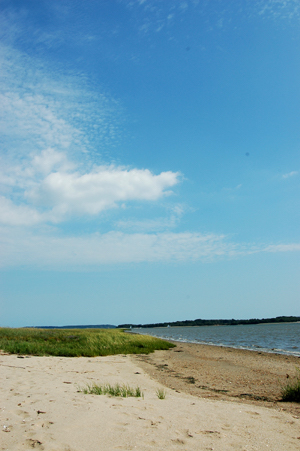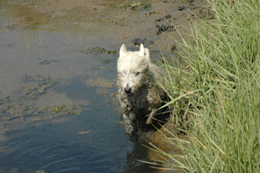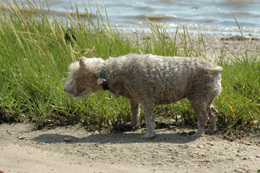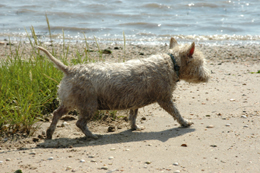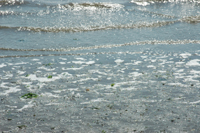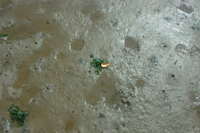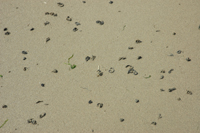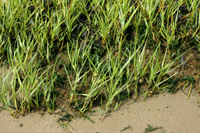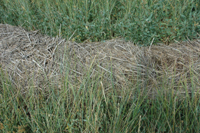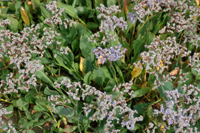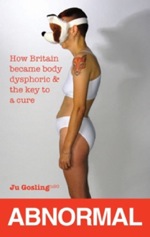Visit 6: 3 - 9 August 2006
Having left London under grey skies, we arrive in Dorset to find bright sunshine again, although thankfully not the boiling heat of the previous week. I've just found out that I've been awarded grant funding for the next year from the Wellcome Trust's Sciart fund, so am feeling very positive. This will pay for a one-day-a-week residency at the National Institute of Medical Research (NIMR), as part of their art programme. Among other things, I will be researching a book about cultural attitudes to the body, and developing a 'scientific' model of disability. To date, disability theory has not distinguished between science and medicine. However, there is actually remarkably little cross-over between medical scientific researchers and medical practitioners. One of the two scientists that I will be working with, though, Dr Evelien Gevers, practises medicine at Great Ormond Street children's hospital in addition to researching at NIMR, which will be very helpful. I have had a number of meetings at NIMR to plan the project, and am really looking forward to working with Evelien, as well as with the other scientist, Dr Malcolm Logan. The project will also fit in very well with my work at Holton Lee, both in terms of developing disability theory and developing the art/science relationship between Holton Lee's arts and environmental programmes. Once the van has been unloaded (thanks again, Trish and Stewart), I just have time for a quick change before heading over to Faith House for the private view of the new exhibition, Response. This is a group exhibition by the Bournemouth Arts Club/Southern Contemporaries, produced in response to the environment at Holton Lee. I meet a number of the artists, including Sarah Moore, who has created an installation in the woods together with Minna Harvey which I promise to find during my visit. Frances Hatch, who coordinated the exhibition, has produced a living installation by taking the earth from a mole hill, germinating the seeds contained in the soil and allowing it to grow naturally. Visitors are encouraged to water it if they feel that it needs it! I am particularly taken with this because the caravan shares its home with a mole, and often has new mole hills surrounding it when I wake up in the morning. It is interesting to see just how much life is contained in what often appears to be a pile of lifeless dusty soil: there are so many different plants growing. Frances couldn't be present this evening, but we all drink a toast to her.
After an hour or so, Genie and I head over to the Farm House for Holton Lee's monthly music evening. This is coordinated by Fred, one of the p.a.s who works at the Barn. I have previously sampled Fred's roast Sunday dinner - highly recommended! - but I have not seen him with his musical hat on before. There was a music night on my very first visit, but this is the first time that I have been down during a music night since. We join a group of guests from the Barn, some local disabled people, Julie, who has travelled down with me, and other Holton Lee staff. The focus tonight is on folk, which of course is currently enjoying a mainstream revival. Fred and his friend Richard, who heads Holton Lee's 'Green Team' volunteers, lead on their guitars, while the rest of us stick firmly to the percussion instruments that he has provided. Fred finds me a small plastic egg filled with beads, which turns out to be my most accessible percussion instrument yet! My right wrist and hand have been very weak since my illness in 2000, which has severely restricted my ability to play any instrument. After surgery two years ago I have recovered some strength and a lot of feeling, but still find playing difficult. Light plastic shakers are however my best percussion instrument, and the egg is both very light and easy to hold. I am not entirely sure that it looks any sillier than the silver plastic house music maraccas that I have been playing previously!
(By the way, I have been asked why I mention my physical experiences here, including my impairments and how these affect me. As I discuss in my article What is Disability Arts?, some disability activists believe that any discussion of impairment is contributing to the dominance of the medical model of disability. However, feminists believe that it is always important to discuss physical experiences, particularly when these differ from those of non-disabled heterosexual white men. This means that a disabled feminist viewpoint might be different from a mainstream disability viewpoint. In addition to this, when I was researching my PhD, I realised that the physical experience of research was never mentioned. And while a great many theories had been developed around the relationship between the research process and gender/race/sexuality, none whatsoever had been developed on the relationship between the research process and disability. This was the reason that I produced my 'extra' thesis, My Experiences as a Disabled Researcher. I believe that physical experience always impacts on research, and should therefore be made visible. I also believe that the research process is affected by experience of disability, as it is by gender/race/sexuality. None of this detracts from the fact that what disables me is not my impairments, but rather social and environmental barriers that have been artificially created and which are entirely unnecessary. Impairment itself is simply a normal part of the human condition: it is society that disables me.) Genie, who as usual enjoyed people admiring her at the private view, looks singularly glum at the prospect of the music evening. Last August we went to the Women in Tune festival in Wales, and she got very used to sitting on my lap while a silver plastic maracca was shaken in her ear for hours during music workshops. She didn't, however, have much enthusiasm for it, and actually much preferred the performances, particularly the Tramadolls who play driving rock music. I couldn't decide then, and still can't, whether she is naturally extremely tolerant of loud noise, or whether she deafened herself through repeated loud barking sessions when she was younger. Unfortunately she was extremely charmed when she first learned that she could bark, and took every opportunity to practice. This does however have the benefit for me of her being able to raise the alarm if I am taken ill, as well as meaning that she was born to go clubbing. Fortunately she has never shown any desire to join in with singing, so she settles down resignedly at my feet instead. Apart from Genie, we all enjoy the music evening a great deal. In fact, I enjoy it so much that I become aware that I have had a wine spritzer at the private view and a couple of small beers during the music evening, but haven't eaten since lunchtime! Trish saves the day with a run to the chip shop, after which even Genie cheers up and shows off by catching the chips which are thrown to her. At the end of the evening, Fred is kind enough to give me the purple plastic egg, which - bizarrely - makes a great end to the day. As we get ready for bed, I can hardly believe that I have just arrived.
The next morning sees me in the office, helping Trish to research what equipment will be needed for the new dedicated digital studio within the Stables studio complex. The studio will be used for digital archiving, as well as for hire to artists. Holton Lee already holds a lot of photographic negatives and transparencies and videos, as well as photograpic prints, and these will need transferring to digital formats as part of the archiving process. Images of all of the objects within the National Disability Arts Collection and Archive (NDACA) will also be available on its website, and so will need processing first. (It will be possible to order copies of still images and selected films etc from NDACA, depending on the copyright position.) Our job now is to decide what equipment will be necessary, and to find out how cheaply we can buy it. I search the net, while Genie sleeps under the desk. By the end of the morning, we are satisfied that we have a shopping list, and just have to knock 20% off the cost in order to be able to afford it within our budget! Fortunately it is always possible to make considerable savings on the list price of software and electronic equipment by shopping around, so we agree that I will do this on Monday. Once the studio is open for business, I will also be able to start working with our new trainee, Hayley. My afternoon is already fully booked, as I need to work on the caravan as well as getting a tent put up next to us. Karen Shook, who performs 'sit-down' comedy as The Wheelchair from Hell, is coming to stay and is due to arrive in the evening. Karen is my Co Chair at Regard, the national organisation of disabled lesbians, gay men, bisexuals and transgendered people. She is also a senior NHS disability equality adviser, and will give us some feedback on improving the access at Holton Lee even further. I start, though, by trying to assemble the new high-powered television aerial that I have bought in order to improve the television picture in the caravan to a point where it is at least watchable. Ordinarily I have no difficulty with assembling electronics, being undeniably geeky, but on this occasion the instructions are indecipherable. Fortunately Derek, the gardener, is passing and offers to help. He probably ends up regretting this, as it takes us nearly an hour to complete it and it is very hot work. At the end of it all, the picture is no better . . . Derek suggests that we try to raise the aerial up next, and promises to return.
In the meantime, Stewart and his friend Rob arrive to help with the tent. I am feeling particularly stupid this afternoon, and am unable to explain how to put it up despite a long history of camping. (One very enjoyable element of this job for me is the opportunity to rediscover my Queen's Guide teenage self as necessary.) Still, how hard can it be to work out which are the two short poles, then to thread them through the tent, crossing them over in the middle before putting in the final, long pole in the remaining space? Actually, very hard indeed - we must have tried every possible combination before discovering the right one. I have two cold beers in the fridge, which helps to ensure that finally we do manage to get the tent up with the added help of Derek and Les, one of the p.a.s who is passing. At this point, though, we discover that the soil is a mixture of mole hills and stones. Either a tent peg won't go in at all, or it comes straight out again. It is therefore the end of the afternoon before we feel confident that, so long as the wind doesn't get up, the tent should - probably - stay up! Note to self: next time use the small tent, and/or put it up somewhere else.
Derek then comes back with what seems at first sight to be a huge metal pole, along with a roll of gaffer tape. He fixes the aerial to the pole, and then tapes it to the caravan. Unfortunately the picture is no better than before . . . I get out the aerial instructions again and read 'the quality of the co-axial cable used is as important as the quality of the aerial itself'. Since I have reused the old - very old - cable, it seems best to try replacing this next. However, I have now lost the desire ever to watch television again, so decide to put this off till next time. Instead Genie and I thank Derek and then cross Twin Oak Tree field and head for the woods, as she hasn't had a long walk since she arrived. We look out for both wild ponies and Sarah and Minna's installation, but fail to find either. We both enjoy ourselves, though, and I continue to be impressed by how well Genie helps me to balance my electric scooter on such rough terrain: the walk is really only possible because of her. Once we reach the heathland Karen phones to say that she is close by, and we head back to the lane to guide her in and welcome her - after checking briefly that the tent is remaining upright! We then settle down to a meal of spit roast chicken from the Co-op, accompanied by organic vegetables from Derek's garden. I had forgotten that it is eviction night, but manage to retrieve the television situation by managing to get the sound on my pocket video monitor. The next day is Saturday, so after a late start we set off with Karen to explore the area a little. Our first stop is Wareham, the nearest town, where we do our household shopping. I also manage to get some bits and pieces for the caravan from the hardware and charity shops. Then we head for Kimmeridge, which has a marine wildlife reserve along its coast. The car park attendant lets us drive in for free, but we discover that there is no apparent access to the beach. However, the view from the car park is great and it seems possible to get access from the boat slipway further up the beach, although we decide to leave trying that till another time. It is actually quite cool today, although there are still a lot of people in swimming costumes. After this we return via Corfe Castle. We start off in the visitors' car park at the bottom of the hill, where there is also an exhibition centre and accessible toilets. This is interesting, but we discover that the main facilities are adjacent to the castle at the top of the village, including the refreshments. Enquiries about whether we can drive up meet with a very unenthusiastic response, as parking facilities are limited and 'you wouldn't want to go there'. This makes us determined that we will, and sure enough it turns out to be possible to park if you are a Blue Badge holder - or indeed, if you are just lucky enough to get a space. We are particularly interested to find the 'Ginger Pop Shop', supposedly devoted to Enid Blyton but actually containing a wide range of old-fashioned toys and souvenirs. As so often, a totally unexpected link has been made between my interest in school stories, and particularly my smallpress company Bettany Press, and my art activities.
After this we are exhausted, and return to Holton Lee to barbecue the food that we bought in Wareham. On turning over our camping chairs, though, I discover a large collection of flying ants' eggs nested in one of the seats. Sometimes you can come into too close contact with nature! So, as Karen is fascinated and willing to deal with it, I set off for the site of the archive building pleading the urgent need for some documentation. In particular, I photograph some of the habitats around the site, including the many rabbit burrows around the edges. Later, Karen pronounces the paw prints leading down them to be foxes', before reaching into one of the burrows and retrieving a milk bottle from around the end of the 19th century with all the aplomb of taking a rabbit out of a hat. Karen originally trained as an archaeologist and explains that items often get turned up by rabbits, but the thought of reaching into a burrow has too many horror-movie connotations for me and I decide not to follow her example. Sunday is a big day - the day of the tenth annual Holton Lee Horse Show, organised by Margaret Newell. By Saturday the fields leading down to the foreshore had all been cut in preparation, tapes marking off the different showing rings had appeared, and a couple of caravans had arrived on the site, but apart from that all was quiet. However, when we wake up on Sunday morning horse boxes and classic cars have already started arriving, and by 9am it is all in full swing. We go over to watch Denise, who volunteers at Holton Lee's Riding for the Disabled stables, compete (and get placed) in the carriage driving, and also to pick up early bargains on the bric-a-brac stalls, before going up to the Barn for our ablutions. The Horse Show is also hosting the second annual Holton Lee dog show and I have decided to enter Genie, partly to support the show and partly to give her more experience with groups of dogs. We were never been able to access formal group training, as I was taken ill just before she was due to start as a puppy and haven't been able to access local sessions since. We have done one group training weekend recently, with Dog AID who supervise all of her training, and it was clear that Genie was nervous in large groups of dogs. Genie has already been so upset by seeing hordes of dogs all over a site where few are usually allowed that I wonder whether to forget the idea, but decide to go ahead with preparations anyway. This involves taking her into the bathroom with me, and giving her a shampoo as best I can! She has been bathed before coming down, but as usual has become filthy within the first 48 hours. When we come out I keep her wrapped in a towel on my lap, so as to avoid any contact with the dirt until she is dry again. This also has the effect of disguising the fact that I have not been alone in the bathroom, as I hurriedly exit the Barn and return to the caravan!
After a thorough brushing, we return to the show and enter for two classes: 'prettiest bitch' (no 7) - surely our class - and 'the dog the judge would most like to take home' (no 16) - on occasions, I wish they would! At first Genie is outraged at all the dogs who have invaded 'her' territory, but quickly settles down and makes friends with the dogs sitting near us round the ring. The show is a 'fun' show, but it becomes clear that it is still taken very seriously by all concerned and that it is going to be a very long process. However, there are certainly some funny moments, albeit mostly unintentional, particularly when a chihuahua sets out to walk round the ring and nearly disappears in the bumpy ground. We half expect a weir rabbit to pop up, seize it and return underground with it, but instead the chihuahua refuses to move after its fright and its owner has to carry it round instead! In fact, we nearly miss Genie's first class, as I have had to leave to find an accessible portaloo and been held up coming back by something catching my eye on the bric-a-brac stall! Perhaps unsurprisingly, we are both very confused, and leave feeling that no judge in the world would ever pick us. As a result, we nearly leave before the end of the show, when I remember that I have still not had any lunch and have been baking in the heat for some hours. But things speed up and we return to the ring for the last class, along with most of the rest of the competitors. To my amazement - but perhaps not to Genie's - she is placed fifth, and presented with a rosette. Suddenly it has all been worth it, and she is the best dog in the world. Life is even better when Julie presents me with a hot dog, which I share with the one next to me. By this time we are all exhausted, and spend a very quiet evening. On Monday I am back in the office, along with a very clean but very tired dog who heads under the desk with relief. Trish has already added a photo of Genie receiving her rosette to the next Holton Lee newsletter! I do, though, eventually manage to focus on the studio shopping list, and by the end of the morning have priced everything within our budget by searching all of the shopping sites to find the best deals: artists have to be good at finding a bargain. I also start proofing the newsletter for Trish, and agree to input the changes for her the next day.
Genie continues to be very subdued, but perks up at the end of the afternoon, after she has rolled in a mole hill and reduced her coat back to a light shade of grey. In the evening, Karen, Julie, Genie and I go for a long potter through the woods to the far bird hide, where Karen is able to identify the birds that we see for us. We also spot the deer herd, so Genie and I withdraw to allow Karen to get closer without us frightening them. By Tuesday morning, most traces of the horse show have gone, and we only have the rosette to remind us of Sunday's events. Genie and I return to the office to help Trish, but leave at lunchtime so I can spend the afternoon taking photographs. Julie and Karen are going carriage driving, so Genie and I are heading for the foreshore. This can only be reached by crossing over a railway bridge, and then by abandoning the scooter and proceeding on foot. The combination of the extremely hot summer and the extended time away from concrete surfaces has allowed me to build up my fitness, and as this is necessarily temporary I am determined to make the most of it. I grew up by the sea, and have always been interested in the foreshore as the shifting boundary between water and land. The fact that Holton Lee borders Poole Harbour also creates the amazing light that the site enjoys, and I am very interested in exploring this within my work. Genie and I manage to get along the path and down to the beach without too much difficulty, and she is delighted to be there. She bounces in and out of the water, rolling in the sand and seaweed in between times. She now looks far less like the dog who won a rosette on Sunday, but does, it has to be said, look more like herself! After a rest, I am able to take a lot of photographs - some of which you can see here - which will act as reference points for future work. Then we return slowly to the caravan, glad that the bullocks had been removed from the fields because of the horse show. Karen and Julie have had a great time, and go out on the Trampers after tea to do more bird-spotting, but Genie and I are exhausted.
Genie returns her appearance
to normal
Wednesday marks our return to London, which inevitably involves several hours of packing despite help from willing volunteers. Leaving is also a slow process because there are increasing numbers of people to say goodbye to, several of whom pop in for a chat and lend a hand at the same time. Tony has just returned from his holiday, so I break for half an hour or so and meet with him to discuss the funding application for NDACA. This is now nearly complete, which is a great relief. When I return in September, we will be able to start work on NDACA itself.
Images of the foreshore
Click here to read the next entry Click here to return to the blog entries Click here to return to the top of the page All contents © 2006 |

